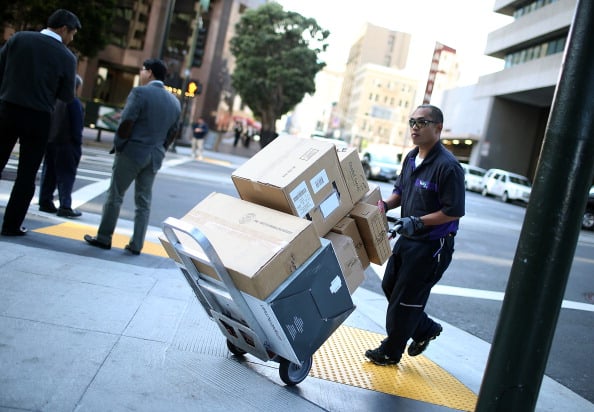How 2 Dozen Startups Could Do What FedEx Does, But Better

Your Reaction?
Source: iStock
Move fast and break things.
This Silicon Valley mantra for quick iteration has acquired a new and an even more hurried meaning in recent times. The media industry was one of the first to disaggregate, and now engineers from the Valley have mounted similar attacks on other industries.
mantra for quick iteration has acquired a new and an even more hurried meaning in recent times. The media industry was one of the first to disaggregate, and now engineers from the Valley have mounted similar attacks on other industries.
Charts outlining the breakup of traditional industries have been making the rounds on blogs and posts from VC firms. There is one about the disaggregation of the banking industry, for example. Retail banking, which started out as a simple lending operation, has become a complex mesh of products that span multiple functions, including investment, trading and banking operations. Startups are beginning to sort this complexity into simple operations and niches.
But the chart that’s perhaps the most interesting relates to the logistics industry. A key facilitator of global trade and distribution, which is valued at approximately $20 trillion each year, the logistics industry represents modern business operations in all their complexity.
operations in all their complexity.

Your Reaction?
Source: CB Insights
It encompasses multiple business processes, modes of operations, and a variety of transportation mechanisms. In fact, the supply chain is considered a key differentiator between companies. For example, Apple CEO Tim Cook is reportedly an expert in supply chain, and this expertise is part of the company’s competitive edge.
is considered a key differentiator between companies. For example, Apple CEO Tim Cook is reportedly an expert in supply chain, and this expertise is part of the company’s competitive edge.
As the graphic makes clear, the FedEx business has four business lines, with each business aimed at specific customers. FedEx Express or FedEx Ground is aimed at average individual customers. The freight shipments business is aimed at prosumers, while the the Air/Ocean Freight Forwarding business is aimed at business organizations and large cargo shipments.
business has four business lines, with each business aimed at specific customers. FedEx Express or FedEx Ground is aimed at average individual customers. The freight shipments business is aimed at prosumers, while the the Air/Ocean Freight Forwarding business is aimed at business organizations and large cargo shipments.
To service these customers, the Dallas-based company has invested in massive infrastructure and transportation networks that can be leveraged across all four of its businesses to provide cheap services. This enables economies of scale and helps the firm cross-sell its products across multiple product and customer segments.
But it also adds complexity and bureaucracy in the company. In turn, this leads to bad customer service. With a more focused approach, startups bring efficiency and agility to each business process, shaking up the establish model. Here are three ways startups are doing just that.
1. Aggregating rates and scheduling pickups
Currently, FedEx and UPS manage the entire value chain of logistics.
This includes collecting shipments, transporting them across distances, and making the last delivery stop. This is a capital and labor intensive operation and, as mentioned earlier, promotes inefficiencies.
A combination of smartphone and barcode technology has made it simpler and easier for startups to manage parts of this process more efficiently as compared to large carriers. Logistics startups, such as Shyp and ShipBob, aggregate quotes from multiple carriers and enable customers to select the cheapest available option.
Their mode of operation is the same as that of price aggregation engines, such as Kayak or Priceline. But logistical operations come with the additional responsibility of picking up and dropping packages.
Startups have zeroed in on this gray area by deploying additional workers and technology solutions (such as an app) to make the process more efficient. Noticeably, while both FedEx and DHL have home pick-up options, they are constrained by their business model in offering a price comparison engine for customers.
Other startups, such as Shippo and ShipHawk, have taken a slightly different approach and provide rates and shipping through respective vendors. But they make the process easier by enabling custom printing of forms and labels for printing.

Your Reaction?
Justin Sullivan/Getty Images
2. Customizing delivery options by solving the last mile problem
The “last mile” problem in logistics is when you miss a package delivery. It is a headache for delivery companies because it increases delivery costs. It is also a problem for real estate management companies because it adversely affects service levels for their apartment complexes.
In response, a number of online retailers, such as Google Shopping and Amazon, have either devised their own solutions or acquired startups to make the process simple.
The tech startup approach has been characteristic. They have disaggregated the process and aggregated providers. For example, companies like Parcel Pending provide lockers for customers to access their packages. Another startup, Doorman, has developed an app that informs customers about their delivery at the Doorman’s chosen locations so that they can pick up their package in their free time.
3. Eliminating physical storefronts
Dropshopping has become an increasingly common e-commerce practice. In this supply chain model, retailers do not own inventory. Instead, they connect directly to the backend (in this case, the wholesale retailer) to supply products. In this case, the online retailer’s role is restricted to marketing and, also, connecting the customer and wholesale retailer. In logistical terms, this is known as order fulfillment.
The growth of online retail has resulted in a corresponding increase in dropshipped products. This is because a number of online retailers choose not to invest in expensive inventory and warehousing space. For logistics companies, such as FedEx and UPS, this could be an ideal solution because it increases the order volume in their database.
Good blog... This is very useful information for last mile delivery. Need more information about last mile delivery startups. Thanks for sharing
ReplyDelete